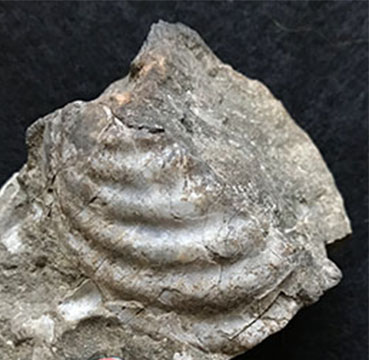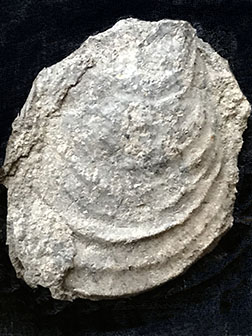The name Inoceramus is Greek, meaning “strong pot.” This genus, which ranges from the Permian? Period (about 255 million years ago) to very near the end of the Cretaceous Period (about 68 million years ago), is very useful for geologic time correlation. Species of this genus were lived epifaunally on the ocean floor in depths ranging from nearshore sands to deep-sea muds. Their larvae were readily dispersed by currents, and some species became widely distributed. They preferred temperate waters.
Inoceramus is characterized by having a thin shell with relatively few morphologic characters to distinguish it from similar looking genera; also, the species of Inoceramus can be morphologically similar. In general, both the valves of Inoceramus are somewhat lowly inflated, and they are longer than they are wide. Concentric ribs are common, but radial ribs are rare. The prismatic microstructure of their shells, as well as minute details of their hinges, are useful in helping to differentiate Inocermamus from some other similar looking Mesozoic (Jurassic and Cretaceous) bivalves (e.g., Buchia). Some species of Inoceramus have a small posterior winglike extension, which makes them superficially resemble “winged pearly oysters” of the extant bivalve genus Pteria.
Overall Inoceramus valves resemble “Ruffle Potato Chips.” Some workers have lumped species, whereas others have overnamed them. Specimens can range up to giant size (3 meters in length!). While alive, these giant valves could serve as a shelter for schools of small fish, which have been found preserved as impressions inside of the bivalves.
Inoceramus subundatus Meek, complete specimen, (a) left valve and (b) right valve, Late Cretaceous (Campanian Stage), h 6 cm, w 5 cm. Southern California, California.
Inocermaus subundatus Meek RLS collection, incomplete right-valve specimen, h 4.5 cm, w 3.7 cm. Late Cretaceous (Campanian Stage), Chatsworth Formation, Simi Hills, southern California.
Inoceramus sp. Partial valve, h 8 cm, w 5 cm, Late Cretaceous (upper Santonian Stage), Wheeler Springs area, southern California. Specimen is in situ in the outcrop.






No comments:
Post a Comment